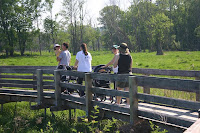Kat posts about the impromptu Goose Pond Mountain trip...
It was too nice to stay at home, so in the window of time after school and before dinner we decided to get out to our local haunt. Sybil, Nathan, Anderson, and Olivia were waiting in their van as I pulled into the Goose Pond Mountain parking lot. They hopped out to climb on the big rocks while I got ready, and as I was buckling the girls into their stroller, Laurel, Sebastian and Acadia arrived. After stowing some equipment in various places in the stroller, the big kids, armed with nets, headed off to the tadpole pond at great speed, leaving behind a cloud of dust. The stroller group followed slowly in their footsteps.
It was a slightly cool late afternoon. Laurel and Sybil searched the pond for the American Toad tadpoles, curious to see where they would be that day. At each visit, the tadpoles had been found in different spots in the pond, though curiously all still together in one gigantic wriggling mass. They make their rounds along the perimeter of the pond, swimming in one enormous stream of wiggly black dots. This behavior is very interesting, and Laurel noted she had never observed this in tadpoles before. Perhaps, because we were almost daily visitors to Goose Pond, we were now privy to more of the secrets of the world around us.
As I waited with the kids and the strollers, Laurel and Sybil went to see if there was indeed water flowing just past the tree line to the west of the pond. I had seen glimpses of it when the vegetation was low, but I wasn't sure if it was another vernal pool or if it was indeed a steady stream. As I waited, Acadia and Penelope took turns playing with the buckles on the stroller. Lily pointed out butterflies as they fluttered by. Sybil came back first, toting Olivia in her front carrier. Laurel had gone a bit farther, and when she returned she reported that there was indeed a stream flowing through that area. She described it as a slightly deep and somewhat fast-flowing brook roughly 7 or 8 feet wide. Climbing over downed trees and matted vegetation, she had spotted a turtle basking on a log. It plopped into the water as she tried to get a closer look. The discovery of the stream was an exciting prospect; this meant there was another area of Goose Pond to explore.
Anderson, who had recently become a big brother, took an interest in Lily and Penelope as they were released from the confines of their stroller and were allowed to walk with the older children along the boardwalk. He was attentive and gentle, guiding the girls over to the second and third ponds. Penelope babbled incessantly to him, perhaps telling him about the snake she had seen there the week before. He listened with interest. As we paused at the bench between the two ponds, I snapped a picture of all of the children (minus Olivia, who was still snuggled against Sybil's chest) playing with each other on this gorgeous afternoon. Because the children were otherwise occupied, Sybil was able to grab a free pond net and scooped up an enormous bullfrog tadpole, observing that it was so large it could be marinated and grilled for dinner! Lily and Penelope decided they also wanted to try out the nets to see what they could catch, though they still need a bit of practice. Perhaps thinking of the tadpole and dinner, the families headed back to their cars to go home.





 Toadlets emerging! Can you find one? It's no bigger than the letter "C" in the Canon logo.
Toadlets emerging! Can you find one? It's no bigger than the letter "C" in the Canon logo.
















































